Related Research Articles
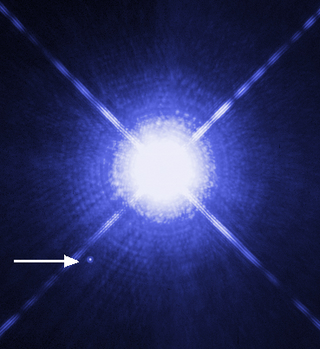
A white dwarf is a stellar core remnant composed mostly of electron-degenerate matter. A white dwarf is very dense: its mass is comparable to the Sun's, while its volume is comparable to Earth's. A white dwarf's low luminosity comes from the emission of residual thermal energy; no fusion takes place in a white dwarf. The nearest known white dwarf is Sirius B, at 8.6 light years, the smaller component of the Sirius binary star. There are currently thought to be eight white dwarfs among the hundred star systems nearest the Sun. The unusual faintness of white dwarfs was first recognized in 1910. The name white dwarf was coined by Willem Luyten in 1922.

Brown dwarfs are substellar objects that have more mass than the biggest gas giant planets, but less than the least massive main-sequence stars. Their mass is approximately 13 to 80 times that of Jupiter (MJ)—not big enough to sustain nuclear fusion of ordinary hydrogen (1H) into helium in their cores, but massive enough to emit some light and heat from the fusion of deuterium (2H). The most massive ones can fuse lithium (7Li).
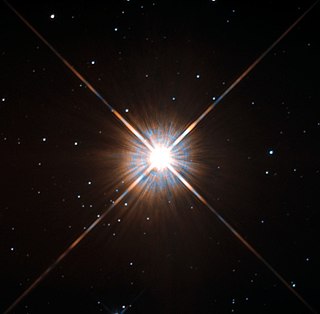
A red dwarf is the smallest and coolest kind of star on the main sequence. Red dwarfs are by far the most common type of star in the Milky Way, at least in the neighborhood of the Sun. However, individual red dwarfs cannot be easily observed as a result of their low luminosity. From Earth, not one star that fits the stricter definitions of a red dwarf is visible to the naked eye. Proxima Centauri, the nearest star to the Sun, is a red dwarf, as are fifty of the sixty nearest stars. According to some estimates, red dwarfs make up three-quarters of the stars in the Milky Way.

A super-Jupiter is a gas giant exoplanet that is more massive than the planet Jupiter. For example, companions at the planet–brown dwarf borderline have been called super-Jupiters, such as around the star Kappa Andromedae.

A carbon planet is a theoretical type of planet that contains more carbon than oxygen. Carbon is the fourth most abundant element in the universe by mass after hydrogen, helium, and oxygen.
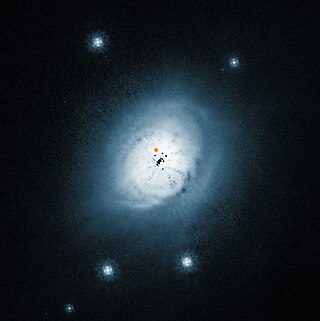
HD 100546, also known as KR Muscae, is a pre-main sequence star of spectral type B8 to A0 located 353 light-years from Earth in the southern constellation of Musca. The star is surrounded by a circumstellar disk from a distance of 0.2 to 4 AU, and again from 13 AU out to a few hundred AU, with evidence for a protoplanet forming at a distance of around 47 AU.

CT Chamaeleontis (CT Cha) is a T Tauri star - a primary of the star system in the constellation of Chamaeleon. It has an apparent visual magnitude which varies between 12.31 and 12.43. The star is still accreting material at rate 6×10−10 M☉/year.
CoRoT-2 is a yellow dwarf main sequence star a little cooler than the Sun. This star is located approximately 700 light-years away in the constellation of Aquila. The apparent magnitude of this star is 12, which means it is not visible to the naked eye but can be seen with a medium-sized amateur telescope on a clear dark night.

WISE 1828+2650 is a possibly binary brown dwarf or rogue planet of spectral class >Y2, located in the constellation Lyra at approximately 32.5 light-years from Earth. It is the "archetypal member" of the Y spectral class.

KOI-256 is a double star located in the constellation Cygnus approximately 575 light-years (176 pc) from Earth. While observations by the Kepler spacecraft suggested the system contained a gas giant exoplanet orbiting a red dwarf, later studies determined that KOI-256 was a binary system composed of the red dwarf orbiting a white dwarf.
HR 2562 b is a brown dwarf or gas giant exoplanet. It is a substellar companion of the debris disk host star HR 2562. HR 2562 is a sixth-magnitude F-type main-sequence star located 110.92 ± 0.16 light-years (34.007 ± 0.048 pc) away. HR 2562 is about 37% more massive than the Sun.
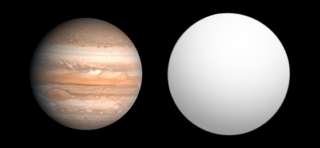
CoRoT-14b is a transiting Hot Jupiter exoplanet found by the CoRoT space telescope in 2010.
CoRoT-20b is a transiting exoplanet found by the CoRoT space telescope in 2011.

DH Tauri, also known as DH Tau, is a type M star, located 140 parsecs away. It forms a binary system with DI Tauri 15″ away, and has a substellar companion, either a brown dwarf or massive exoplanet.
HD 7449 is a binary star system about 126 light-years way. The primary star, HD 7449 A, is a main-sequence star belonging to the spectral class F9.5. It is younger than the Sun. The primary star is slightly depleted of heavy elements, having 80% of solar abundance.
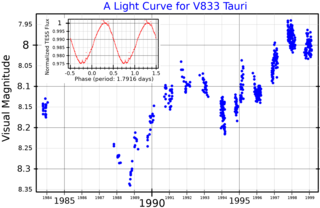
HD 283750, also known as V833 Tauri, is a K-type main-sequence star 57 light-years away from the Sun. The star is much younger than the Sun's at 1 billion years. HD 283750 is similar to the Sun in its concentration of heavy elements.
References
- ↑ "Notes on CoRoT-20 c". Extrasolar Planets Encyclopaedia . Retrieved February 25, 2019.
- ↑ Rey, J.; Bouchy, F.; Stalport, M.; Deleuil, M.; Hébrard, G.; Almenara, J. M.; Alonso, R.; Barros, S. C. C.; Bonomo, A.; Cazalet, G.; Delisle, J. B.; Díaz, R. F.; Fridlund, M.; Guenther, E. W.; Guillot, T.; Montagnier, G.; Moutou, C.; Lovis, C.; Queloz, D.; Santerne, A.; Udry, S. (2018). "A 4.6-year period brown-dwarf companion interacting with the hot-Jupiter CoRoT-20 b". Astronomy & Astrophysics. A115: 619. arXiv: 1807.01229 . doi:10.1051/0004-6361/201833180. S2CID 126274116.